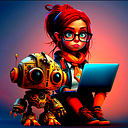From Clicks to Emotions: The Psychology Behind Effective Design
✔ Understanding the Human Mind
To create truly effective designs, we must understand the psychology behind human behavior. By delving into the intricacies of how people think, feel, and make decisions, we can design interfaces that resonate on a deeper level.
Supporting Heart Area❤️
📚 The Psychology of Perception
- Visual Hierarchy: The strategic arrangement of elements on a page to guide user attention.
- Color Psychology: The use of color to evoke emotions and influence behavior.
- Typography: The choice of fonts and typography to enhance readability and aesthetics.
⚙️ Cognitive Load and Mental Models
- Cognitive Load: The mental effort required to process information.
- Mental Models: The mental representations users form about how a system works.
- Chunking: Breaking down information into smaller, more manageable chunks.
💻 The Power of Emotion
- Emotional Design: Creating designs that evoke positive emotions.
- Delightful Interactions: Using subtle animations and micro-interactions to surprise and delight users.
- Empathy: Designing with empathy for the user’s needs and experiences.
👩💻 The Science of Persuasion
- Social Proof: Leveraging the power of social influence to persuade users.
- Scarcity Principle: Creating a sense of urgency to encourage action.
- Reciprocity: Offering something of value to encourage users to reciprocate.
💫 The Art of Storytelling
- Narrative Design: Using storytelling techniques to create engaging user experiences.
- Brand Storytelling: Building a strong brand identity through storytelling.
- Emotional Storytelling: Eliciting emotions through storytelling to create memorable experiences.
💼 The Business Impact of Effective Design
- Increased User Engagement: Well-designed products and services keep users coming back for more.
- Improved Conversion Rates: Effective design can lead to higher conversion rates and increased sales.
- Enhanced Brand Reputation: A strong brand identity and positive user experiences can build trust and loyalty.
🤝 The Future of Design
The future of design is exciting and full of possibilities. As technology continues to evolve, so too will the role of the designer. Some key trends to watch include:
- AI-Powered Design: Leveraging AI to automate tasks, generate design ideas, and personalize user experiences.
- Voice Interfaces: Designing voice-activated interfaces that are natural and intuitive.
- Immersive Experiences: Creating immersive experiences using VR, AR, and MR.
By understanding the psychology behind human behavior, designers can create products and services that are not only functional but also emotionally resonant.
If you found this article helpful, attractive, useful and would like to support me, make sure to:
Supporting Heart Area❤️
— — — — — — — — — — — — — — — — — — — — — — — — — — — — — — — — —
Authored by: [Niamh]
This collaborative research-driven exploration required [1] day of dedication and [2 to 3] hours of meticulous crafting.
Let’s get connected on Twitter: [@niamh_dcreator]
Thank you for your interest.
— — — — — — — — — — — — — — — — — — — — — — — — — — — — — — — — —
